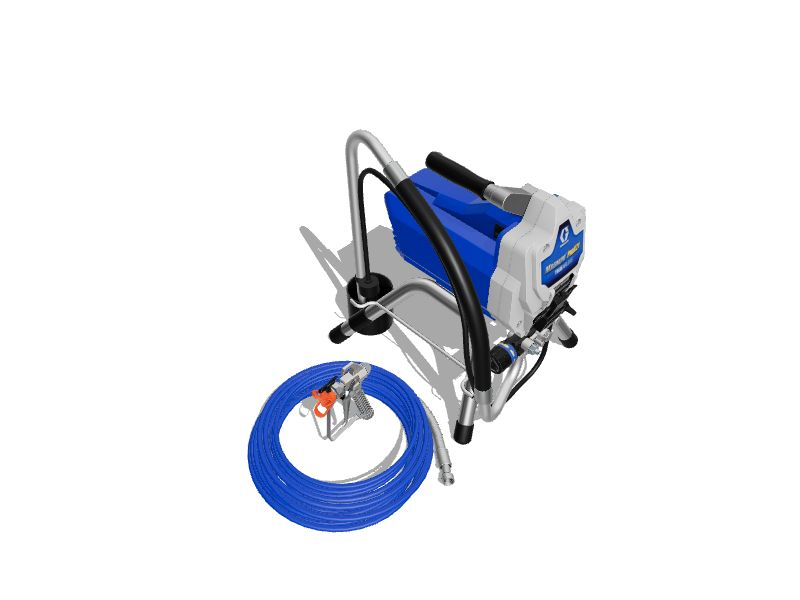The method of replacing the sprayer part is not a very easy task. You should be very careful if you want to replace the sprayer part. For better quality, you must keep given these points.
Choosing a Spray Tip and a Tip Size
Spray tips are available with different hole sizes to accommodate a range of fluid sprays. There is a tip on your sprayer that can be used for most paint-spraying tasks. To find the range of suggested tip hole diameters for each fluid type.
• For thicker coatings, use bigger tip hole sizes; for thinner coatings, use smaller tip hole sizes.
• Tips eventually wear out and need to be replaced. The size of the tip hole regulates the flow rate, or how much paint is discharged from the gun.
Fan Width
The area covered by each stroke of the spray pattern is determined by its size.
Some pointers are as follows:
• Choose a fan width that is ideal for the surface that will be sprayed;
• On large, open surfaces, wider fans can offer superior coverage.
Better control is possible on smaller, more constrained surfaces with narrower fans.
Kit for Lacquer Conversion
You must buy lacquer conversion kit 17J873 and adhere to Start-up instructions when utilizing oil-based materials to spray lacquers with the Graco ProX21 Stand Sprayer Parts.
Compatibility of Cleaning Fluid
• Make sure to completely flush the system with water before applying water-based compounds.
• Use mineral spirits or an appropriate oil-based flushing solvent to completely clean the system before applying any oil-based compounds.
• Flush the system with water completely before spraying water-based compounds, as you would with oil-based materials. Before you start spraying the water-based compound, the water coming out of the drain tube should be clear and solvent-free.
• Use mineral spirits or an appropriate oil-based flushing solvent to completely flush the system before spraying oil-based materials after spraying water-based materials. There shouldn’t be any water in the solvent that emerges from the drain tube. Always adhere to the static grounding instructions (for oil-based materials) on page 24 while flushing with solvents.
• Always point the gun at the inside wall of the bucket to prevent liquid from spraying back onto your skin or into your eyes.
Instructions for Static Grounding (Oil-Based Materials)
When the sprayer is flushed or the pressure is released, always use a metal bucket for oil-based compounds that need to be flushed with suitable oil-based flushing solvents.
Observe the local code. Use only metal pails that are conductive and are set on a surface that is grounded, like concrete.
Replacement Guides
Avoid placing the bucket on non-conductive materials like cardboard or paper since this will disrupt the continuity of the grounding. A metal bucket should always be grounded by attaching a ground wire to it. Attach one end of the cable to the pain and the other to a real earth ground, like a water pipe. These replacement guides are for the Graco ProX21 Cart Sprayer Parts. When the sprayer is flushed or pressure is released, hold the metal portion of the gun firmly against the side of a grounded metal bucket and pull the trigger to preserve ground continuity.
Upkeep
To guarantee that your sprayer is operating properly, routine maintenance is essential.
Hoses Without Air
Every time you spray, inspect the hose for damage. If there is damage to the hose jacket or fittings, do not try to repair the hose. Never use hoses that are less than 25 feet (7.6 meters). Using two wrenches, tighten the wrench.
Spray Tips: After spraying, always clean the tips with a brush and cleaning solution that work well together.
• Depending on how abrasive the paint is, tips may need to be replaced after 15 gallons (57 liters) or they may last up to 60 gallons.
Pump Maintenance
Paint will start to seep down the outside of the pump when the packings on the pump wear.
• Before starting your next project, get a pump repair kit and install it according to the product’s instructions.
• Refer to ProXChange Pump, page 42, or get advice from a distributor, service facility, or authorized Graco/MAGNUM reseller.
Removal of the Pump
On sprayers with hoppers, remove the hopper. Take out the airless hose; you might also need to take out the suction tube.
Before beginning any pump repairs, make sure to follow the Pressure Relief Procedure and unplug the sprayer.
1. Turn off the sprayer’s electricity supply.
2. Push the entire easy-access door away from the pump’s input end while pulling the tabs on its sides in your direction.
3. At this point, raise the door so that it swivels aside.
Interval of Activity
- Examine and clean the gun filter, fluid inlet strainer, and InstaClean filter.
- Check for obstructions in the motor shroud holes every day or every time you spray. Every day or every time you apply a spray
- Keep this sprayer’s internal drive components dry. The internal mechanical and electronic components can cool thanks to openings in the shroud. Water intrusion into these holes may cause the sprayer to break down or sustain irreversible harm.
- The pump unit can be slid off the mounting pins.
ProXChange Eradication Instrument
The frame has an inbuilt tool for removing the ProXChange packing component.
For comprehensive repair instructions, refer to the Pump repair handbook. The frame has an incorporated tool for removing the pump’s inlet valve assembly. Remove and clean or replace the valve assembly if you believe the inlet valve is blocked or clogged.
1. Take the hopper or suction tube out of the sprayer.
2. Loosen the intake valve and insert the pump inlet into the frame. Take off the inlet valve.
3. Replace the ball and spring after clearing the cavity of any debris and dried paint. Using the integrated tool on the frame, tighten the pump’s inlet valve.
Conclusion
The tip gets bigger and worn down as you spray. To spray within the sprayer’s rated flow capacity, start with a tip hole size that is less than the maximum.
Also Read: https://usamagazineworld.com/

